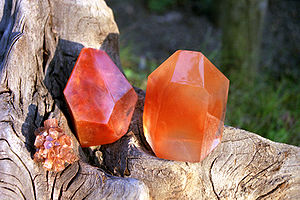Mirah darah
(Dialihkan dari Batu ahmar)
Mirah darah adalah batuan mineral akik merah kecokelatan yang biasanya digunakan sebagai batu permata. Batu ini adalah ragam dari mineral silika kalsedon. Warnanya berasal dari noda bijih besi. Warna dari batu ini bisa sangat beragam, mulai dari jingga pucat sampai hitam sangat pekat. Batu ini umumnya ditemukan di Indonesia, Brasil, India, Rusia (Siberia), dan Jerman.
| Mirah darah | |
|---|---|
 | |
| Umum | |
| Kategori | Kalsedon |
| Rumus (unit berulang) | Silika (silikon dioksida, SiO2) |
| Sistem kristal | Trigonal |
| Identifikasi | |
| Massa molekul | 60 g/mol |
| Warna | Merah kecoklatan |
| Belahan | Tidak ada |
| Fraktur | Tidak rata, serpihan, konkoid |
| Kekerasan dalam skala Mohs | 6–7 |
| Kilau | kaca, kusam, berminyak, halus |
| Gores | Putih |
| Diafaneitas | Tembus cahaya |
| Berat jenis | 2.59–2.61 |
| Referensi | [1] |
Rujukan
sunting- ^ Rudolf Duda and Lubos Rejl: Minerals of the World (Arch Css, 1990)
Bacaan lanjut
sunting- Allchin, B. 1979. "The agate and carnelian industry of Western India and Pakistan". – In: South Asian Archaeology 1975. E. J. Brill, Leiden, 91–105.
- Beck, H. C. 1933. "Etched carnelian beads". – The Antiquaries Journal, 13, 4, 384–398.
- Bellina, B. 2003. "Beads, social change and interaction between India and South-east Asia". – Antiquity, 77, 296, 285–297.
- Brunet, O. 2009. "Bronze and Iron Age carnelian bead production in the UAE and Armenia: new perspectives". – Proceedings of the Seminar for Arabian Studies, 39, 57–68.
- Carter, A. K., L. Dussubieux. 2016. "Geologic provenience analysis of agate and carnelian beads using laser ablation-inductively coupled plasma-mass spectrometry (LA-ICP-MS): A case study from Iron Age Cambodia and Thailand". – J. Archeol. Sci.: Reports, 6, 321–331.
- Cornaline de l'Inde. Des pratiques techniques de Cambay aux techno-systèmes de l'Indus (Ed. J.-C. Roux). 2000. Éditions de la Maison des sciences de l'homme, Paris, 558 pp.
- Glover, I. 2001. "Cornaline de l'Inde. Des pratiques techniques de Cambay aux techno-systèmes de l'Indus (sous la direction de V. Roux). – Bulletin de l'École française d'Extrême-Orient, 88, 376–381.
- Inizan, M.-L. 1999. "La cornaline de l’Indus à la Mésopotamie, production et circulation: la voie du Golfe au IIIe millénaire". – In: Cornaline et pierres précieuses. De Sumer à l'Islam (Ed. by F. Tallon), Musée du Louvre, Paris, 127–140.
- Insoll, T., D. A. Polya, K. Bhan, D. Irving, K. Jarvis. 2004. "Towards an understanding of the carnelian bead trade from Western India to sub-Saharan Africa: the application of UV-LA-ICP-MS to carnelian from Gujarat, India, and West Africa". – J. Archaeol. Sci., 31, 8, 1161–1173.
- Kostov, R. I.; Pelevina, O. (2008). "Complex faceted and other carnelian beads from the Varna Chalcolithic necropolis: archaeogemmological analysis". Proceedings of the International Conference "Geology and Archaeomineralogy". Sofia, 29–30 October 2008. Sofia: Publishing House "St. Ivan Rilski": 67–72.
- Mackay, E. 1933. "Decorated carnelian beads". – Man, 33, Sept., 143–146.
- Theunissen, R. 2007. "The agate and carnelian ornaments". – In: The Excavations of Noen U-Loke and Non Muang Kao (Eds. C. Higham, A. Kijngam, S. Talbot). The Thai Fine Arts Department, Bangkok, 359–377.
Pranala luar
suntingWikimedia Commons memiliki media mengenai Carnelian.

